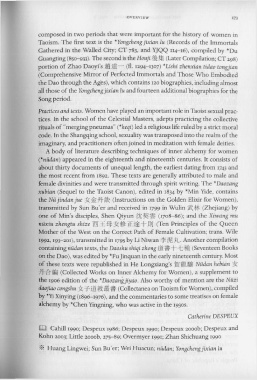Page 213 - The Encyclopedia of Taoism v1_A-L
P. 213
OVERVIEW 173
composed in two periods that were important for the history of women in
Taoism. The first text is the *Yongcheng jixian lu (Records of the Immortals
Gathered in the Walled City; CT 783, and YJQQ II4-16), compiled by *Du
Guangting (85D-933)· The second is the Houji ~~ ~ (Later Compilation; CT 298)
portion of Zhao Daoyi's MiJ1!- (fl. 1294- 1307) *Lishi zhenxian tidao tongjian
(Comprehensive Mirror of Perfected Immortals and Those Who Embodied
the Dao through the Ages), which contains 120 biographies, including almost
all those of the Yongchengjixian lu and fourteen additional biographies for the
Song period.
Practices and texts. Women have played an important role in Taoist sexual prac-
tices. In the school of the Celestial Masters, adepts practicing the collective
rituals of "merging pneumas" (*heqi) led a religious life ruled by a strict moral
code. In the Shangqing school, sexuality was transposed into the realm of the
imaginary, and practitioners often joined in meditation with female deities.
A body of literature describing techniques of inner alchemy for women
(*niidan) appeared in the eighteenth and nineteenth centuries. It consists of
about thirty documents of unequal length, the earliest dating from 1743 and
the most recent from 1892. These texts are generally attributed to male and
female divinities and were transmitted through spirit writing. The *Daozang
xubian (Sequel to the Taoist Canon), edited in 1834 by *Min Yide, contains
the Nujindanjue ~~f)-~ (Instructions on the Golden Elixir for Women),
transmitted by Sun Bu'er and received in 1799 in Wulin Ji\~A* (Zhejiang) by
one of Min's disciples, Shen Qiyun tt~~ (1708-86); and the Xiwang mu
nuxiu zhengtu shize W I -Ht ~ {~ lE j£ + J:!U (Ten Principles of the Queen
Mother of the West on the Correct Path of Female Cultivation; trans. Wile
1992,193-201), transmitted in 1795 by Li Niwan *rJP,n. Another compilation
containing nudan texts, the Daoshu shiqi zhong ~. + -t:;fI (Seventeen Books
on the Dao), was edited by *FuJinquan in the early nineteenth century. Most
of these texts were republished in He Longxiang's }l ~~.m Nudan hebian ~
pt if t.)\jij (Collected Works on Inner Alchemy for Women), a supplement to
the 1906 edition of the *Daozangjiyao. Also worthy of mention are the Nuzi
daojiao congshu ~T~~llt!f (Collectanea on Taoism for Women), compiled
by *Yi Xinying (1896-1976), and the commentaries to some treatises on female
alchemy by *Chen Ymgning, who was active in the 1930S.
Catherine DESPEUX
W Cahill 1990; Despeux 1986; Despeux 1990; Despeux 2000b; Despeux and
Kohn 2003; Little 2000b, 275- 89; Overmyer 1991; Zhan Shichuang 1990
* Huang Lingwei; Sun Bu'er; Wei Huacun; nudan; Yongchengjixian lu

